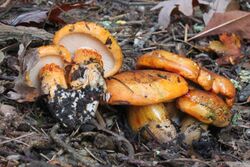Biology:Tricholoma aurantium
| Tricholoma aurantium | |
|---|---|

| |
| Scientific classification | |
| Domain: | Eukaryota |
| Kingdom: | Fungi |
| Division: | Basidiomycota |
| Class: | Agaricomycetes |
| Order: | Agaricales |
| Family: | Tricholomataceae |
| Genus: | Tricholoma |
| Species: | T. aurantium
|
| Binomial name | |
| Tricholoma aurantium (Schaeff.) Ricken (1915)
| |
| Synonyms[1] | |
| |
Tricholoma aurantium, commonly known as the golden orange tricholoma, is a mushroom of the agaric genus Tricholoma. Originally described by Jacob Christian Schäffer in 1774,[2] it was transferred to the genus Tricholoma by Adalbert Ricken in 1915.[3]
Description
The cap is broadly convex to more or less flat, measuring 3–9 cm (1.2–3.5 in) wide with an margin that is initially rolled inward. Fresh specimens are sticky or slimy. The cap color is orange to dull reddish-orange. Parts that have been handled bruise dark red. The surface texture ranges from smooth to covered with scattered appressed fibrils and scales. The closely spaced gills are whitish, but develop brownish to reddish-brown stains in maturity. They are narrowly attached to the stipe, sometimes by a notch. The often hollow stipe measures 4–8 cm (1.6–3.1 in) long by 1–2 cm (0.4–0.8 in) thick, and is either roughly the same width throughout, or tapers slightly to the base. Its surface is covered with dense orangish scales that terminate in a line near the top of the stipe, where it is white. The white, mealy tasting flesh does not change color with injury.[4]
The spore print is white. Spores are smooth, ellipsoid, and inamyloid, measuring 5–6 by 3–4 µm.[4] The mushroom is inedible.[5]
Habitat and distribution
The fungus grows in a mycorrhizal relationships with various species of conifers. Fruit bodies grow scattered or in groups or clusters on the ground.
Tricholoma aurantium is widely distributed in North America.[4] It is found in Asia (India,[6] Pakistan[7]). The ectomycorrhizae of T. aurantium has been reported with Pinus wallichiana and Abies pindrow in Pakistan,[7] and with silver fir (Abies alba) in Italy.[8]
Chemistry
Tricholoma aurantium fruitbodies contains the novel diterpene lactone compounds trichoaurantianolides A,[9] B, C and D.[10] The bright orange-red color is due to the benzotropolone pigment aurantricholone.[11] The first total synthesis of trichoaurantianolides C and D was reported in 2015.[12]
See also
| Tricholoma aurantium | |
|---|---|
| Mycological characteristics | |
| gills on hymenium | |
| cap is convex or umbonate | |
| hymenium is adnate or adnexed | |
| stipe is bare | |
| spore print is white | |
| ecology is mycorrhizal | |
| edibility: inedible or edible, but unpalatable | |
- List of North American Tricholoma
- List of Tricholoma species
References
- ↑ "Tricholoma aurantium (Schaeff.) Ricken :332, 1915". MycoBank. International Mycological Association. http://www.mycobank.org/BioloMICS.aspx?Table=Mycobank&Rec=27669&Fields=All.
- ↑ Schaeffer JC. (in Latin). Fungorum qui in Bavaria et Palatinatu circa Ratisbonam nascuntur Icones. 4. Regensburg, Germany. p. 18.
- ↑ Ricken A. (1915) (in German). Die Blätterpilze. 1. Leipzig, Germany: Weigel. p. 332.
- ↑ 4.0 4.1 4.2 100 Cool Mushrooms. University of Michigan Press. 2010. pp. 191–2. ISBN 978-0-472-03417-8. https://books.google.com/books?id=jhll7DJcnrwC&pg=PA191.
- ↑ Phillips, Roger (2010). Mushrooms and Other Fungi of North America. Buffalo, NY: Firefly Books. p. 47. ISBN 978-1-55407-651-2.
- ↑ Abraham SP. (1993). "Larger Fungi from Kashmir-X". Indian Journal of Forestry 16 (3): 204–213. ISSN 0250-524X.
- ↑ 7.0 7.1 "New records of ectomycorrhiza from Pakistan". Pakistan Journal of Botany 42 (6): 4335–4343. 2010. http://www.pakbs.org/pjbot/PDFs/42%286%29/PJB42%286%294335.pdf.
- ↑ "Fungi in ectomycorrhizal associations of silver fir (Abies alba Miller) in Central Italy". Mycorrhiza 7 (6): 323–328. 1998. doi:10.1007/s005720050200.
- ↑ "Trichoaurantianolide A, a new diterpene with an unprecedented carbon skeleton from Tricholoma aurantium". Tetrahedron Letters 36 (11): 1905–1908. 1995. doi:10.1016/0040-4039(95)00109-P.
- ↑ "The structures of trichoaurantianolides B, C and D, novel diterpenes from Tricholoma aurantium". Tetrahedron Letters 36 (17): 3035–3038. 1995. doi:10.1016/0040-4039(95)00420-H.
- ↑ "Novel benzotropolone and 2H-furo[3,2-b]benzopyran-2-one pigments from Tricholoma aurantium (Agaricales)". European Journal of Organic Chemistry 2000 (4): 603–608. 2000. doi:10.1002/(SICI)1099-0690(200002)2000:4<603::AID-EJOC603>3.0.CO;2-5.
- ↑ "Total synthesis of neodolastane diterpenes trichoaurantianolides C and D". The Journal of Organic Chemistry 80 (11): 5474–5493. 2015. doi:10.1021/acs.joc.5b00355. PMID 25974179.
Wikidata ☰ Q458173 entry
 |

